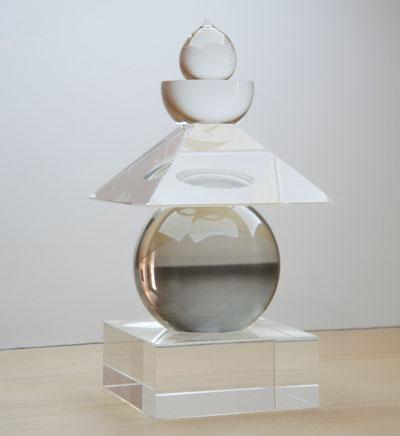Hiroshi Sugimoto at Tripoli

The simple yet elegant presentation of works by Hiroshi Sugimoto at the Tripoli Gallery in Southampton begins at the entrance to the gallery. Like the restrained, masterly crafted boxes he makes for his glass sculptures, the gallery has been turned into discreet packaging for the jewels within its walls.
The exhibition begins out on the street, where just the small letters of the artist’s name are apparent on the introductory wall. A passageway leading into the gallery reveals a single photograph in the back room, but the view confounds any other effort to see the show without entering.
Once inside, a glass sculpture from the artist’s “Five Elements” series beckons. The beautifully stacked shapes would be enough to intrigue and admire, but they contain an added enhancement, namely a miniaturized view of one of the images of “Seascapes‚” the series that hangs on the walls of the back gallery.
Tripoli Patterson worked with the artist and his representatives, who offered precise instruction on the installation. Images of the same body of water must hang together, he was told, and very little of the show should be revealed until inside the gallery. It required a reconfiguration of space, which not only works marvelously for the show, but should serve the gallery well in the future.
The first room features the gallery’s desk behind a wall, with a view out the side window and the single glass sculpture, “Five Elements: Boden Sea, Uttwill (1993),” an image taken that year and made into a sculpture in 2011. The piece is one with its pedestal, not merely the optical glass that holds the image and its pagoda-like top, but the support of wood and steel that the artist designed for the sculpture. It is a rough but ingenious base, underlining the object’s preciousness without being precious itself.
The photographs in the next room of the Yellow Sea, the Mediterranean, and Lake Superior, cover over a decade of production. Only eight in all, they are a study in purity. For Hamptons International Film Festival-goers who might be visually overstimulated by day three, this Zen-like exhibition will be the equivalent of staring into the middle distance, but much better. The synced horizon lines and repetitive imagery are a rest to the eyes, but offer volumes to consider.
Repetition allows one to slow down and really see the objects presented. The viewer must pause to take in the differences between them. It could be a blurred horizon line, from the haze or fog that may have been present on the day the artist perched himself on a cliff to take the photos, or the patterns of the ripples on the water. There is much to see in this minimal landscape.
It is a boiling-down of academic principles as well as a certain realm of abstraction that the photographs so serenely represent. The processing of his film is impeccable and the gelatin-silver emulsion is given its highest and best use in the prints, where each detail is so subtly and effectively produced. One leaves the show with a sense of calm, having experienced both pure intellectual engagement and aesthetic pleasure.
The show is on view through Oct. 20.
